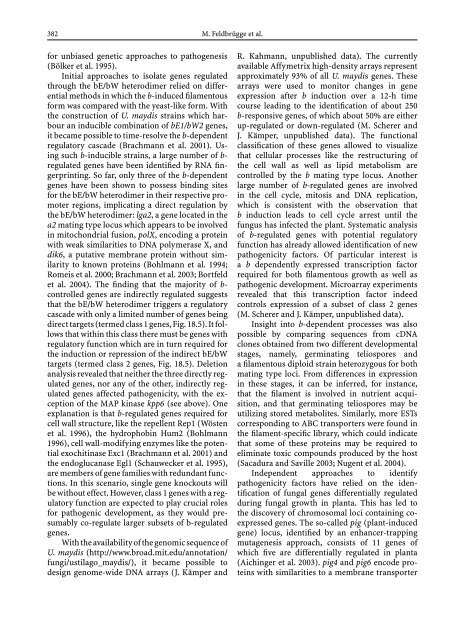Growth, Differentiation and Sexuality
Growth, Differentiation and Sexuality
Growth, Differentiation and Sexuality
Create successful ePaper yourself
Turn your PDF publications into a flip-book with our unique Google optimized e-Paper software.
382 M. Feldbrügge et al.<br />
for unbiased genetic approaches to pathogenesis<br />
(Bölker et al. 1995).<br />
Initialapproachestoisolategenesregulated<br />
through the bE/bW heterodimer relied on differential<br />
methods in which the b-induced filamentous<br />
form was compared with the yeast-like form. With<br />
the construction of U. maydis strains which harbour<br />
an inducible combination of bE1/bW2 genes,<br />
it became possible to time-resolve the b-dependent<br />
regulatory cascade (Brachmann et al. 2001). Using<br />
such b-inducible strains, a large number of bregulated<br />
genes have been identified by RNA fingerprinting.<br />
So far, only three of the b-dependent<br />
genes have been shown to possess binding sites<br />
for the bE/bW heterodimer in their respective promoter<br />
regions, implicating a direct regulation by<br />
the bE/bW heterodimer: lga2, a gene located in the<br />
a2 mating type locus which appears to be involved<br />
in mitochondrial fusion, polX, encodingaprotein<br />
with weak similarities to DNA polymerase X, <strong>and</strong><br />
dik6, a putative membrane protein without similarity<br />
to known proteins (Bohlmann et al. 1994;<br />
Romeis et al. 2000; Brachmann et al. 2003; Bortfeld<br />
et al. 2004). The finding that the majority of bcontrolled<br />
genes are indirectly regulated suggests<br />
that the bE/bW heterodimer triggers a regulatory<br />
cascade with only a limited number of genes being<br />
direct targets (termed class 1 genes, Fig. 18.5). It follows<br />
that within this class there must be genes with<br />
regulatory function which are in turn required for<br />
the induction or repression of the indirect bE/bW<br />
targets (termed class 2 genes, Fig. 18.5). Deletion<br />
analysis revealed that neither the three directly regulated<br />
genes, nor any of the other, indirectly regulated<br />
genes affected pathogenicity, with the exception<br />
of the MAP kinase kpp6 (see above). One<br />
explanation is that b-regulated genes required for<br />
cell wall structure, like the repellent Rep1 (Wösten<br />
et al. 1996), the hydrophobin Hum2 (Bohlmann<br />
1996), cell wall-modifying enzymes like the potential<br />
exochitinase Exc1 (Brachmann et al. 2001) <strong>and</strong><br />
the endoglucanase Egl1 (Schauwecker et al. 1995),<br />
are members of gene families with redundant functions.<br />
In this scenario, single gene knockouts will<br />
be without effect. However, class 1 genes with a regulatory<br />
function are expected to play crucial roles<br />
for pathogenic development, as they would presumably<br />
co-regulate larger subsets of b-regulated<br />
genes.<br />
With the availability of the genomic sequence of<br />
U. maydis (http://www.broad.mit.edu/annotation/<br />
fungi/ustilago_maydis/), it became possible to<br />
design genome-wide DNA arrays (J. Kämper <strong>and</strong><br />
R. Kahmann, unpublished data). The currently<br />
available Affymetrix high-density arrays represent<br />
approximately 93% of all U. maydis genes.These<br />
arrays were used to monitor changes in gene<br />
expression after b induction over a 12-h time<br />
course leading to the identification of about 250<br />
b-responsive genes, of which about 50% are either<br />
up-regulated or down-regulated (M. Scherer <strong>and</strong><br />
J. Kämper, unpublished data). The functional<br />
classification of these genes allowed to visualize<br />
that cellular processes like the restructuring of<br />
the cell wall as well as lipid metabolism are<br />
controlled by the b mating type locus. Another<br />
large number of b-regulated genes are involved<br />
in the cell cycle, mitosis <strong>and</strong> DNA replication,<br />
which is consistent with the observation that<br />
b induction leads to cell cycle arrest until the<br />
fungus has infected the plant. Systematic analysis<br />
of b-regulated genes with potential regulatory<br />
function has already allowed identification of new<br />
pathogenicity factors. Of particular interest is<br />
a b dependently expressed transcription factor<br />
required for both filamentous growth as well as<br />
pathogenic development. Microarray experiments<br />
revealed that this transcription factor indeed<br />
controls expression of a subset of class 2 genes<br />
(M. Scherer <strong>and</strong> J. Kämper, unpublished data).<br />
Insight into b-dependent processes was also<br />
possible by comparing sequences from cDNA<br />
clones obtained from two different developmental<br />
stages, namely, germinating teliospores <strong>and</strong><br />
a filamentous diploid strain heterozygous for both<br />
mating type loci. From differences in expression<br />
in these stages, it can be inferred, for instance,<br />
that the filament is involved in nutrient acquisition,<br />
<strong>and</strong> that germinating teliospores may be<br />
utilizing stored metabolites. Similarly, more ESTs<br />
corresponding to ABC transporters were found in<br />
the filament-specific library, which could indicate<br />
that some of these proteins may be required to<br />
eliminate toxic compounds produced by the host<br />
(Sacadura <strong>and</strong> Saville 2003; Nugent et al. 2004).<br />
Independent approaches to identify<br />
pathogenicity factors have relied on the identification<br />
of fungal genes differentially regulated<br />
during fungal growth in planta. This has led to<br />
the discovery of chromosomal loci containing coexpressed<br />
genes. The so-called pig (plant-induced<br />
gene) locus, identified by an enhancer-trapping<br />
mutagenesis approach, consists of 11 genes of<br />
which five are differentially regulated in planta<br />
(Aichinger et al. 2003). pig4 <strong>and</strong> pig6 encode proteins<br />
with similarities to a membrane transporter

















